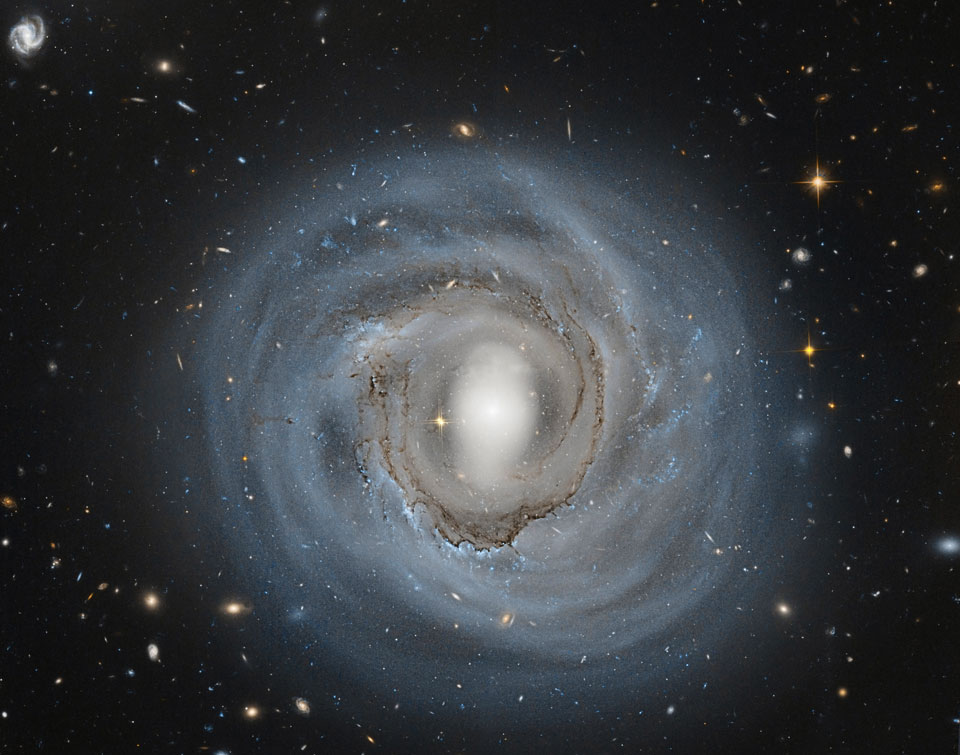As far as I can tell there are only four (4) individual stars from our own galaxy in that picture. Every thing else is a galaxy, or stars in another galaxy. Just take a look at that picture and think about it for a while. Every smudge, every point of light, every fleck of apparently inconsequential light in that image is a mass of billions of stars. Even the smudges of light that may seem like nothing more than dust on the lens is a galaxy.
What is really cool about this image is that even though the image is dominated by the galaxy NGC 4921 you can still see galaxies behind it. Even close to the center if you check out the high resolution image you can see entire galaxies that lie beyond the galaxy in the foreground. What is interesting about those galaxies is that they are probably about the same size as the main galaxy in the image, but because they are so far away they appear to be so much smaller.
Let me highlight some of my favorites from the image.
This comes from the right side just above the center. Galaxy A is a grand design spiral similar to our own galaxy. Just like the main galaxy in the image we are viewing it face on. Based on its shape I would guess that it has somewhere in the neighborhood of 100 billion stars in it. Galaxy B is another spiral galaxy. We can't tell how developed it is and because it is much, much further than either galaxy A or C. Because it is so far away it appears as just a dim smudge, but it is probably the same size as A or C. Galaxy C is much like galaxy A except that we are not viewing it face on. We see it at a slight oblique angle.
Galaxy D is another spiral galaxy that we see at a slight inclination from the plane. It is probably about the same size as A or C, just further away. Galaxy E, yes that insignificant smudge that you thought was random noise in the image, is a galaxy. It is impossible to tell how big that galaxy is from this image or how far away it is but it is a galaxy none the less.
This image comes from the bottom left corner-ish. All the marked galaxies in this image are giant ellipticals. Even though they appear to be approximately the same size as the spiral galaxies near by these ellipticals are actually much, much bigger. When I say much, much bigger I mean 100-1000 times bigger (more massive). They are also much older. The spiral galaxies (in astro-speak) are called late type galaxies. The elliptical galaxies are called early type galaxies. So of course that means that the early type galaxies are old and the late type galaxies are younger (don't ask, the naming convention is there for historical reasons, thank you Edwin Hubble).
What is interesting about galaxy A is that there appears to be a dust lane across the galaxy (either that or another galaxy in front of it). An early type galaxy with a dust lane is not really common. It was interesting to see it.
This image comes from just down from the center. What is really interesting about it is we can see galaxies beyond the main one in the foreground. Galaxy A is a spiral galaxy that we are viewing from an oblique angle. Galaxies B, C and D are viewed edge on. It is interesting that can still see them even through the veil of stars and dust in the foreground. The dark patches are regions of dust that collected after it got blown there from the center of the galaxy after a particularly intense round of star formation.
The star formation was so intense that it effectively stopped star formation in the center of the galaxy and now the only place where stars are forming is in a ring just outside of the dust lanes. The blue patches in the image are regions of star formation in the galaxy.
Try exploring the image a see if there are any other interesting galaxies that you see. I could find at least two mergers and a few other indications of galaxy mergers.




1 comment:
How great Thou art.
Post a Comment